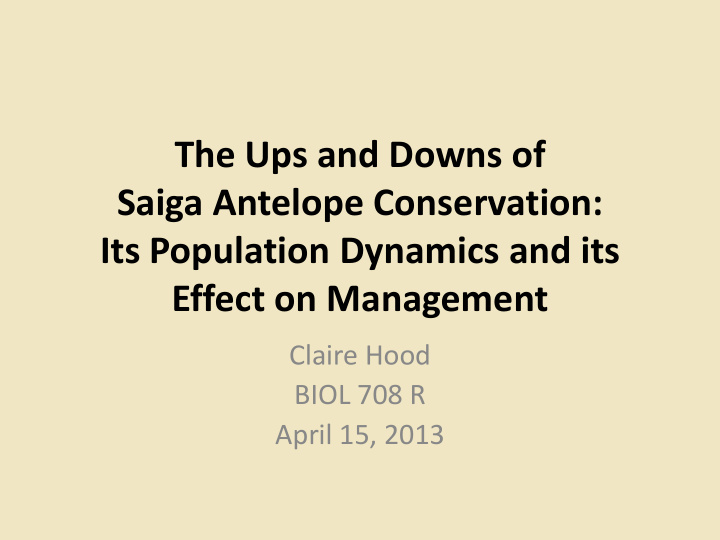



The Ups and Downs of Saiga Antelope Conservation: Its Population Dynamics and its Effect on Management Claire Hood BIOL 708 R April 15, 2013
Ecology of Saiga Antelope • Migratory ungulates • Found in arid deserts, semi- arid deserts, and steppes (grassland plains) of Central Asia • Only wild herbivore in large numbers in the region • Polygynous species with harems • Two subspecies • Saiga tatarica tatarica – located in Kazakhstan. Four sub populations make up 80% of species population • Saiga tatarica mongolia – located in Mongolia. Little known about this subspecies. Number in the 100s. • We’ll be focusing on S. t. tatarica Male saiga antelope
Capable of covering huge distances on a daily basis Two yearly migrations where herds travel up to 1,000 km • Spring migration (north/northwest) to graze on new pastures during ‘green flushes’ Migration • Takes 2-3 months with arrival normally in June • Fall migration to avoid harsh winters • Decide to migrate when rains occur or temperature drops • Takes 3-4 months with arrival in November or December
Rutting and Group Behavior • Gregarious species • Can form groups of ten or one thousand • Large herds during migration and calving • Break up of herds into family groups during lactation • Harems during rutting of 50 or less individuals • Groups are constantly shifting or dispersing • During rutting adult males will fight over females and drive them away from their harem • Protuberant nose swells during rutting • Higher mortality for adult males due to rutting Male saiga antelope during rutting season
Life History & Population Structure • High fecundity – 60% increase in population in one year • Female characteristics • Male characteristics • Fecundity and age correlated (Kuhl 2009) • ‘Boom and bust’ method adapted to environmental stochastity • Rutting males vulnerable to severe winters • Females and calves vulnerable to summer droughts • All vulnerable to dzhuts • At birth, sex ratio is 1:1 • In adults, females far outweigh males • More skewed because of hunting Small group of saiga antelope
Limiting Factors • Human influences – Primarily poaching/hunting – Loss of habitat and desertification • Climate influences – Severe winters – Summer Droughts – Dzhuts • Climate change • Predators – wolves • Parasites and disease
Decline of the Saiga Antelope Background on Harvesting • Saiga have been hunted for centuries for meat, hide and horns • Horns are used in Chinese traditional medicines as fever reducer • Current population decline caused by poaching and lack of management Box of saiga horn for sale online
History of Management 1920s – Populatio n crashed because 1990 – of Fall of 1994 – 2004 – harvest. USSR and Listed in Listed as Only few end of CITES critically 100 managem Appendix endangered remaining ent II by IUCN 1950 – 1990s – 2003 – Beginning The use Surveys of of saiga show managem horns as saiga ent. #s alternativ antelope increase e to populatio 1,000,000 elephant n have tusks declined 95% Population has crashed from 1,000,000 in 1990s to 50,000 in 2003. But populations are now beginning to rebound.
Drop in Female Fecundity due to Hunting bias towards Males • Since males only have horns, poaching has led to a a hugely skewed sex ratio • Population fell to 50,000 in 2002, a decline of 95% with small male percentage. • Harems normally have 1 male with 15-30 females with males fighting over females. • Now harems have ballooned and adult females push other females out of the harem. • Can be seen in graph with failure of first-years to breed. Blue diamonds – adult females Yellow triangles – juvenile females Red diamonds – Average Milner-Gulland 2003
Current Management Efforts • Protected nationally in Russia and Kazakhstan • Listed in Appendix II of CITES • Listed in Appendix II of Convention on Migratory Species • But poaching still a major problem with little law enforcement • Kazakhstan has funded anti-poaching enforcement and aerial surveys • Russia has passed legislation for “emergency conservation efforts” for its population and funded surveys • China has placed controls on horn stocks in markets • Several NGO projects underway
Moving Forward • More research is necessary on migratory habits • Increased enforcement against poaching is needed • Efforts to strengthen livelihoods of rural poor • Protected areas should be established along migratory routes in both summer and winter areas • Corridors should be established in migratory areas with high human presence • Cooperation and coordination between Russia and Kazakhstan • Management should considering changes in climate considering its effect on the species Saiga antelope female with calf
Literature Cited • Bekenov, A.B. et al. The ecology and management of the Saiga antelope in Kazakhstan. Mammal Review , 28 (1998) 1-52. • Kuhl, A. et al. Monitoring population productivity in the saiga antelope. Animal Conservation, 12 (2009): 355-363. • Milner-Gulland, E.J. et al. Reproductive collapse in saiga antelope harems. Nature , 422 (2003): 115. • Singh, N.J.; Milner-Gulland, E.J. Conserving a moving target: planning protection for a migratory species as its distribution changes. Journal of Applied Ecology, 48 (2011): 35-46. • Singh, N.J. et al. Tracking greenery across a latitudinal gradient in central Asia – the migration of the saiga antelope. Diversity and Distributions , 16 (2010): 663-675.
Recommend
More recommend